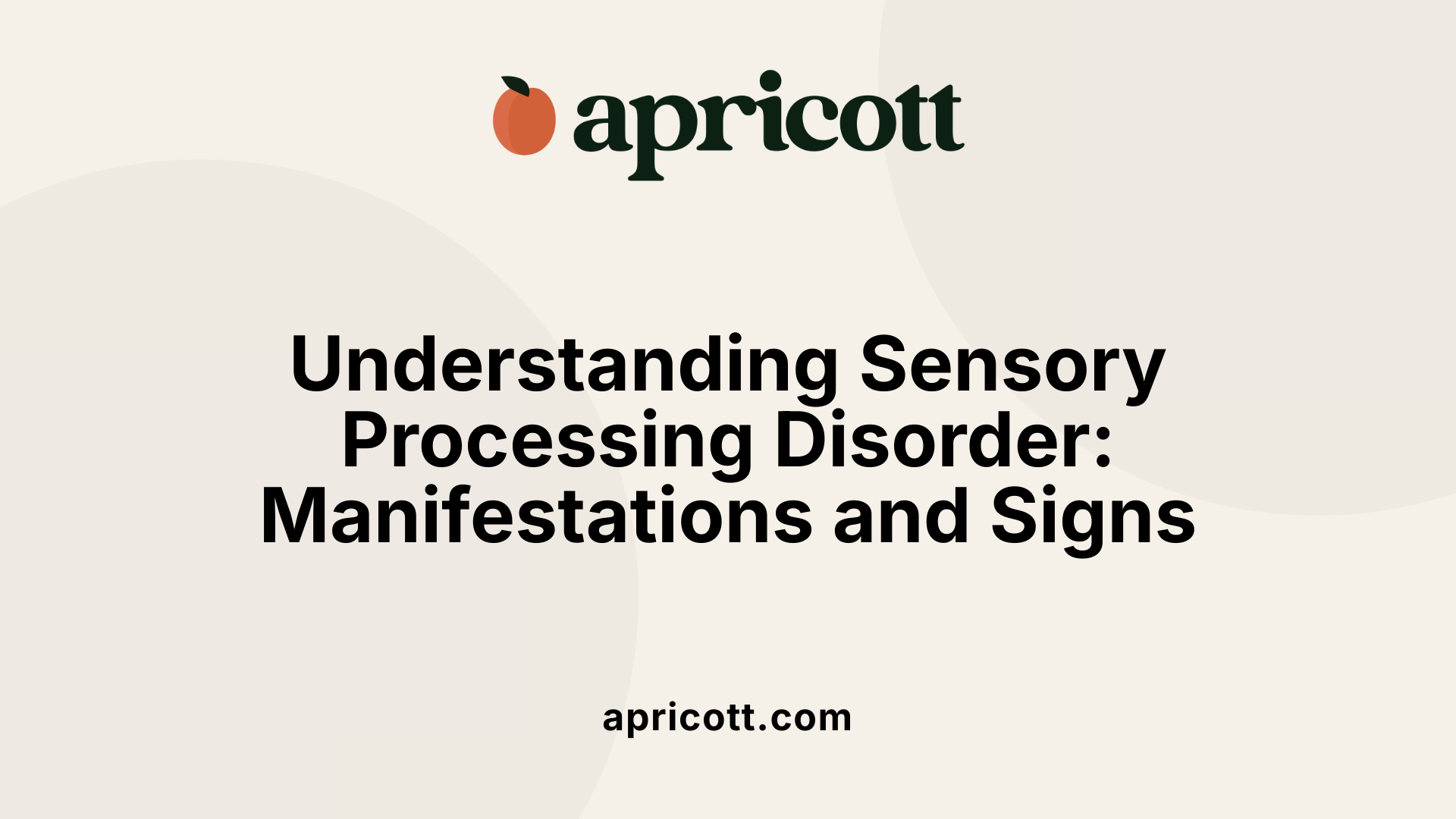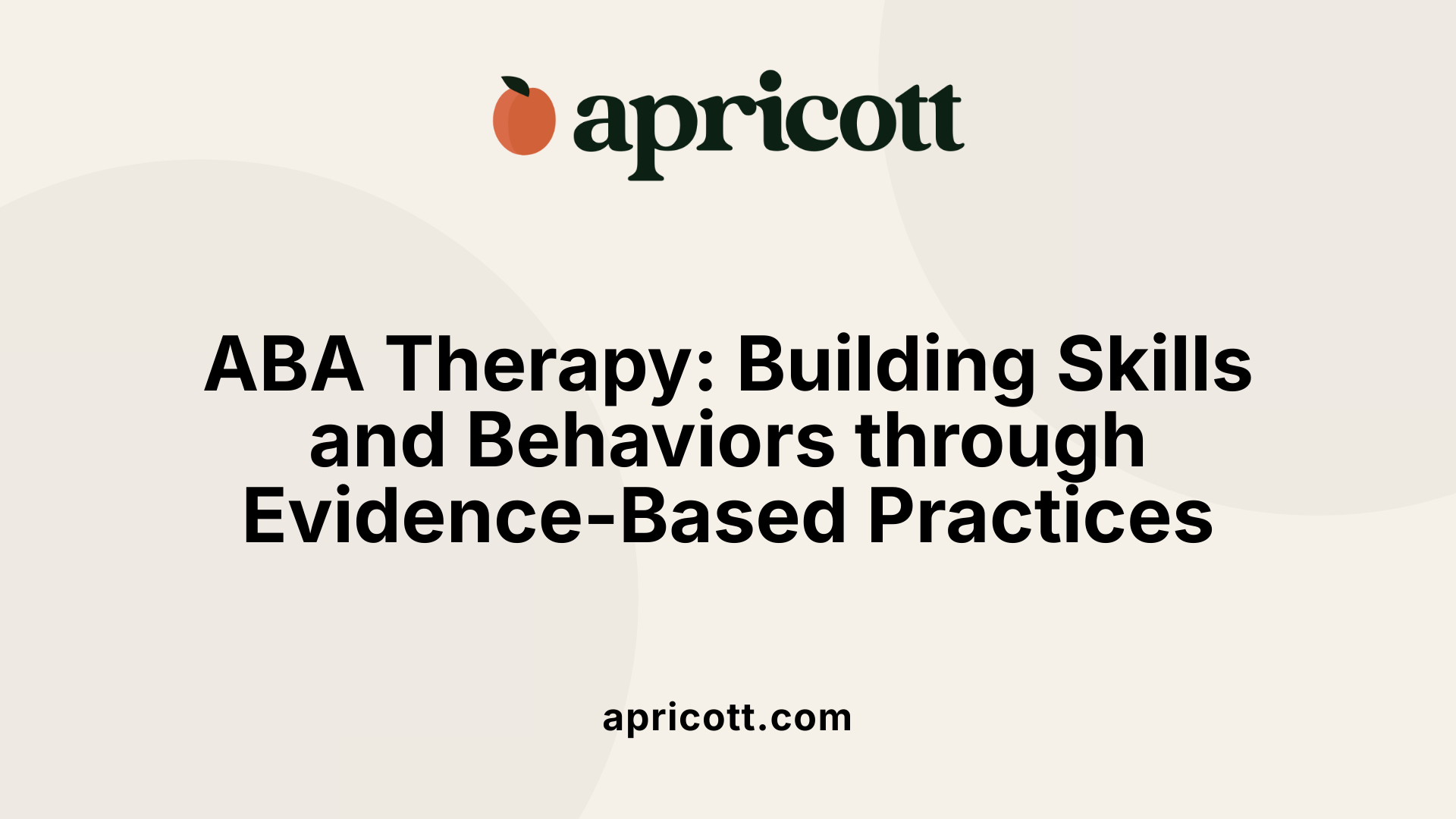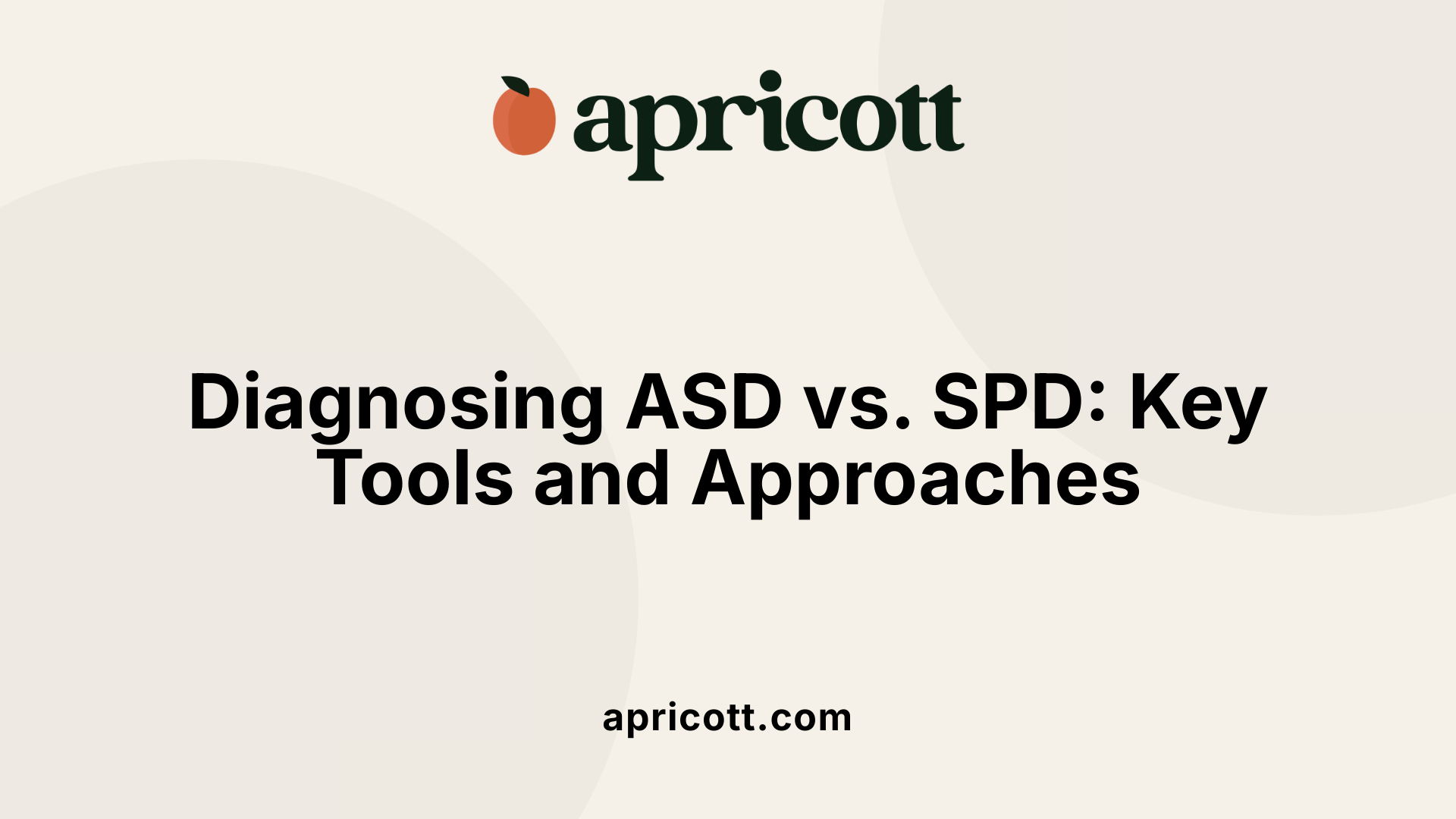Exploring the Overlap and Distinctions Between Sensory Processing Disorder and Autism Spectrum Disorder
Sensory Processing Disorder (SPD) and Autism Spectrum Disorder (ASD) are both conditions that often involve sensory challenges, but they differ significantly in scope, symptoms, and impacts on behavior and social functioning. This article dives into the complexities of these conditions, exploring how sensory processing issues manifest uniquely and the importance of targeted interventions such as Applied Behavior Analysis (ABA) therapy for those on the autism spectrum. Understanding these differences can help families and professionals make informed decisions about diagnosis and support strategies.
What is Sensory Processing Disorder (SPD) and How Does It Manifest?

What is Sensory Processing Disorder (SPD)?
Sensory Processing Disorder is a neurological condition that affects how the brain receives, interprets, and responds to sensory input such as sound, touch, movement, or light. Unlike autism, SPD primarily involves challenges in sensory regulation without necessarily impacting social interaction or behavior.
How Does Sensory Input Interpretation Differ in SPD?
In SPD, the brain's ability to process sensory information is altered. This can lead to hypersensitivity (over-responsiveness) or hyposensitivity (under-responsiveness) to stimuli. These differences mean individuals might find certain sounds unbearably loud or struggle to register movement or touch in typical ways. Internal senses such as proprioception, vestibular input, and interoception can also be affected.
What Behavioral Signs Indicate SPD in Children?
Children with SPD often show behaviors linked to their sensory experiences. Some may be overly sensitive, reacting strongly to sensory stimuli like textures or noises. Others might seek additional sensory input by engaging in activities like spinning, touching objects repeatedly, or seeking deep pressure. Additionally, children may show delayed or diminished responses to sensory input and may struggle with motor coordination.
How Does SPD Differ from Sensory Issues in Autism?
While many children with autism experience sensory processing challenges, SPD can occur independently and does not inherently affect social or behavioral functions as autism does. Autism encompasses broader difficulties including social communication, behavior, and learning, whereas SPD specifically relates to how sensory information is managed. Children with autism tend to have more severe language and social skill challenges in addition to sensory sensitivities, highlighting distinct profiles for each condition.
Autism Spectrum Disorder: Beyond Sensory Challenges
What Is Autism Spectrum Disorder and Its Core Features?
Autism Spectrum Disorder (ASD) is a neurodevelopmental condition typically appearing within the first three years of life. It primarily affects social communication and behavior. Children with ASD often face challenges like making eye contact, forming relationships, understanding social cues, and may show repetitive behaviors or have limited interests. These core characteristics define the broad scope of ASD.
How Do Sensory Sensitivities Manifest in ASD?
Sensory sensitivities are common in individuals with ASD and are now part of the DSM-5 diagnostic criteria. These sensitivities can include hyperreactivity (over-response), hyporeactivity (under-response), or sensory seeking behaviors. For instance, a child with ASD might be highly sensitive to certain sounds, textures, or lights, which can lead to distress or avoidance. These sensory processing differences affect about 90% of those with autism, influencing their daily experiences.
What Are the Behavioral and Social Impacts of ASD?
Beyond sensory processing, ASD impacts learning, behavior, and social interaction extensively. Children with ASD tend to have more severe language and social difficulties compared to those with Sensory Processing Disorder (SPD). They might struggle with delays in verbal and nonverbal communication, reduced social engagement, and repetitive behaviors which can interfere with daily functioning and relationships.
What Neurological Factors Influence Sensory Processing in ASD?
At the neurological level, sensory challenges in ASD stem from altered neural pathways and sensory gating dysfunction. Studies show under-connectivity in long-distance brain connections alongside over-connectivity in local circuits, particularly affecting fronto-posterior pathways. This neural wiring can lead to difficulties filtering irrelevant stimuli, resulting in sensory overload or fragmented sensory perception. An imbalance in cortical excitation and inhibition also contributes to these sensory, cognitive, and behavioral issues. Additionally, atypical multisensory integration—where the brain’s ability to merge stimuli from different senses is impaired—affects social and cognitive functioning.
Together, these sensory and neurological complexities create a unique profile for ASD that goes beyond sensory challenges alone, requiring comprehensive support and tailored interventions.
Key Differences Between Sensory Processing Disorder and Autism Spectrum Disorder

Scope of SPD vs. ASD
Sensory Processing Disorder (SPD) primarily affects how the brain interprets sensory information, such as sound, touch, movement, and light. It focuses on sensory regulation without necessarily involving social or behavioral impairments. In contrast, Autism Spectrum Disorder (ASD) encompasses a broader range of challenges, including social communication difficulties, behavioral differences, and sensory sensitivities.
Overlap and Distinctions in Sensory Symptoms
While many individuals with ASD experience sensory processing differences — often manifesting as hypersensitivity, hyposensitivity, or sensory seeking behaviors — SPD itself focuses exclusively on sensory input regulation issues. Not all individuals with SPD have autism, distinguishing the two conditions despite some overlapping sensory symptoms.
Co-occurrence Statistics
Research shows a significant overlap, with about 90-95% of children diagnosed with ASD also exhibiting sensory issues similar to SPD. However, SPD can occur independently and does not necessarily include the social and communication challenges found in ASD.
Impact on Social and Communication Skills
Children with ASD tend to have more pronounced difficulties in social interaction, language, and behavior compared to those with SPD. ASD affects how individuals engage with others, understand social cues, and develop communication skills, whereas SPD primarily involves challenges in sensory processing that may impact coordination and response to stimuli but typically spare social communication.
Applied Behavior Analysis (ABA) Therapy: What It Is and How It Helps

What is Applied Behavior Analysis (ABA) therapy?
Applied Behavior Analysis (ABA) therapy is a scientifically supported method focused on understanding and changing behavior by using environmental techniques. It is primarily used to help individuals with autism develop helpful skills such as communication, social interaction, and self-care. ABA works by rewarding positive behaviors through positive reinforcement and examining what happens before and after behaviors to shape desired outcomes.
How does behavioral analysis play a role in autism therapy?
Behavioral analysis within ABA involves breaking down complex behaviors into smaller parts to better understand how and why certain actions occur. Therapists observe patterns and triggers for behaviors, allowing them to tailor interventions that encourage positive behaviors while reducing those that interfere with learning or social interaction.
What techniques are used in ABA?
ABA therapy uses a variety of structured techniques, including:
- Discrete Trial Training (DTT): Teaching skills in small, manageable steps with clear reinforcement.
- Naturalistic Teaching: Encouraging communication and behaviors during everyday activities.
- Task Analysis: Breaking tasks into smaller components to teach each effectively.
- Positive Reinforcement: Rewarding desirable behavior to increase its frequency.
These methods are customized to each person, with continuous assessment and adjustment.
What are the benefits of ABA for individuals with autism?
ABA has a strong evidence base demonstrating its effectiveness in improving social skills, language abilities, and reducing challenging behaviors in children with autism. It promotes independence and enhances overall quality of life by fostering meaningful skills that support daily functioning and learning.
By focusing on observable behaviors and measurable outcomes, ABA therapy provides a structured and systematic approach that supports children with autism in reaching their full potential.
Who Provides ABA Therapy and What Should Families Consider?
Providers of ABA Therapy for Individuals with Autism
ABA therapy is delivered by a team of qualified professionals tailored to meet the needs of children with autism. The primary providers include Board Certified Behavior Analysts (BCBAs), Registered Behavior Technicians (RBTs), and therapists trained specifically in behavioral analysis. These specialists use evidence-based techniques and develop individualized treatment plans using tools like Functional Behavior Assessments to promote social, communication, and behavioral improvements.
Qualifications and Certifications Required
Qualified ABA therapists hold credentials such as BCBA certification, indicating advanced training and expertise in applied behavior analysis. RBTs, supervised by BCBAs, work directly with clients to implement therapy. These certifications ensure providers follow standardized best practices to deliver high-quality support.
Settings Where ABA Therapy is Offered
ABA therapy sessions can occur in multiple settings for greater flexibility and effectiveness. Common locations include the child's home, clinical centers, educational environments, and community spaces. Incorporating family involvement into therapy ensures consistency and skill generalization.
Considerations for Families Selecting Providers
Families should carefully evaluate ABA providers for credentials and experience specific to autism interventions. Selecting providers with a transparent and collaborative approach is crucial to establishing clear communication and joint planning. Therapy should focus on personalized goals, measurable progress, and practical skills like communication and daily living.
Safety protocols, such as staff background checks, and detailed experience records, like the long-standing work of centers such as BASS since 2003, are important for ensuring quality and trust. This comprehensive approach supports optimal outcomes and a positive therapy experience for families and children alike.
Sensory-Based Interventions and Environmental Supports for ASD and SPD

What are sensory integration therapy and sensory diets?
Sensory integration therapy (SIT) is a play-based occupational therapy aimed at helping individuals, especially children, modify their sensory responses. It uses controlled sensory activities designed to reduce sensory distress and improve skills such as motor coordination, social interaction, and adaptive behaviors. Complementing SIT, sensory diets are personalized plans that incorporate specific sensory activities throughout the day to help regulate sensory input.
How do environmental modifications reduce sensory overload?
Creating sensory-friendly environments is crucial for minimizing stress in children with ASD and SPD. This includes reducing bright lights, loud noises, and clutter. Simple adjustments like using soft lighting, soundproofing, or designated quiet spaces help reduce sensory distractions and allow individuals to focus and function better.
What role do assistive technologies and tools play?
Assistive tools — such as noise-cancelling headphones, weighted blankets, fidget devices, and interactive sensory toys — support sensory regulation. These technologies promote engagement, improve social skills, and enhance overall well-being by providing tailored sensory input or comfort.
How do these supports improve daily functioning and reduce distress?
By addressing sensory sensitivities and challenges, these interventions help individuals manage sensory overload and improve behavioral responses. This leads to better motor skills, increased social participation, reduced anxiety, and enhanced ability to engage in daily activities. When combined with other therapies like Applied Behavior Analysis (ABA), these supports contribute to improved quality of life for children with ASD and SPD.
Diagnosis and Assessment: Differentiating ASD from SPD

What are the Diagnostic Criteria for ASD per DSM-5?
Autism Spectrum Disorder (ASD) is diagnosed using the Diagnostic and Statistical Manual of Mental Disorders, Fifth Edition (DSM-5). This includes criteria centered on persistent deficits in social communication and interaction, as well as restricted and repetitive patterns in behavior. Sensory processing differences, such as hyperreactivity or hyporeactivity to sensory input and unusual sensory interests, are also incorporated within the diagnostic framework. Symptoms usually manifest within the first three years of life and must significantly impair daily functioning.
Which Assessment Tools are Used for SPD?
Sensory Processing Disorder (SPD) assessments are distinct and focus on sensory regulation issues without necessarily impacting social functions. Common tools include checklists like the Sensory Processing Measure (SPM), Sensory Profile (SP), and clinical observations conducted by occupational therapists. These evaluations help determine how a child responds to sensory stimuli such as sound, touch, or movement and whether they exhibit behaviors like sensory seeking or avoidance.
Why are Personalized Sensory Assessments like SAND Important?
The Sensory Assessment for Neurodevelopmental Disorders (SAND) is a specialized tool designed to identify an individual's personal sensory preferences and sensitivities. This nuanced assessment supports the creation of tailored intervention plans that address specific sensory challenges. Such personalization is vital given that sensory processing differences vary widely, especially among individuals with ASD or SPD.
How Do Multidisciplinary Evaluations Support Accurate Diagnosis?
Accurate diagnosis of ASD and SPD benefits from multidisciplinary approaches involving psychologists, speech-language pathologists, occupational therapists, and medical providers. For ASD, evaluations often include caregiver interviews, detailed behavioral screenings, and neuropsychological assessments. SPD diagnosis relies heavily on clinical observations and functional evaluations to understand sensory responses. Collaboration among specialists ensures comprehensive understanding and differentiates overlapping sensory symptoms from broader social and behavioral impairments.
Integrating Knowledge for Better Support and Intervention
Distinguishing between Sensory Processing Disorder and Autism Spectrum Disorder is crucial for obtaining the right support and interventions. While SPD primarily impacts sensory interpretation, autism encompasses broader social, communication, and behavioral challenges in addition to sensory differences. Interventions such as Applied Behavior Analysis therapy play a vital role in addressing autism's core symptoms, while sensory integration approaches help manage sensory difficulties in both conditions. Early and accurate diagnosis coupled with individualized, evidence-based therapies can significantly enhance the quality of life for affected individuals and their families. Ongoing research and multidisciplinary collaboration continue to improve our understanding and treatment of these complex developmental conditions, fostering better outcomes for all.
References
- Autism & Sensory Processing Disorder Differences | Inclusive
- Sensory Processing Differences in Individuals With Autism ...
- Sensory Processing Disorder vs. ASD: Overlaps and ...
- What Are Sensory Processing Differences and How Do ...
- Autism vs. Sensory Processing Disorder: Key Differences
- Applied Behavior Analysis (ABA)
- Treatment and Intervention for Autism Spectrum Disorder
- Applied Behavior Analysis (ABA) for Children With Autism
- Applied Behavior Analysis (ABA)
- The Top 10 Reasons Children With Autism Deserve ABA
.svg)
.svg)








